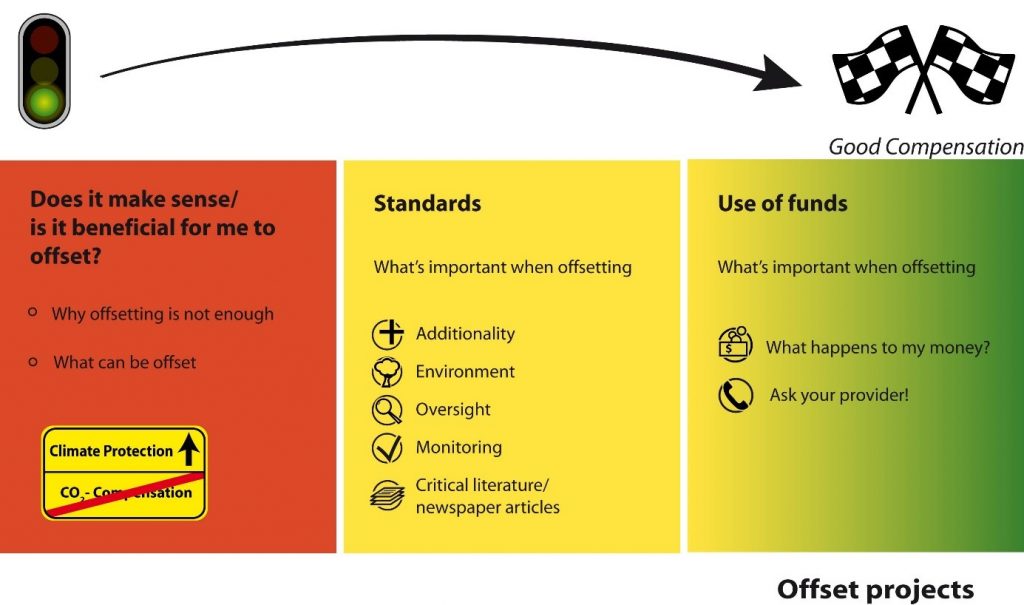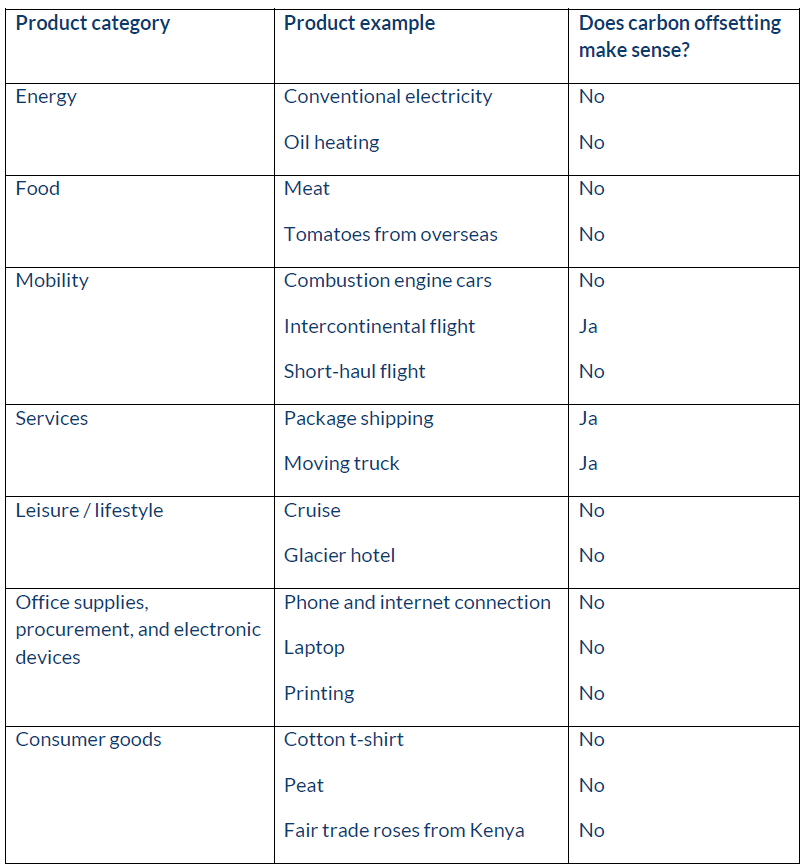When does carbon offsetting make sense?
When seen in terms of climate, offsetting can make sense if the following minimum conditions are met:
- There is no realistic alternative that produces fewer carbon emissions
- The technological potential exists to develop a carbon-free or low-carbon product
- Offsetting follows strict standards and funds are used transparently and completely in the project
Offsetting can play an important support role in efforts to mitigate climate change. We have summarized information about these aspects on this page.

I. Does it make sense for me to offset?
Why offsetting is not enough
Meeting the 2°C target requires global carbon emissions to be at least 80% below 1990 levels by 2050 and be reduced to virtually zero by 2100.
In theory, if the emissions from the Global North were only reduced by offsetting, global emissions would not be lowered enough to reach the emissions targets for 2050 or 2100 (see figure). Even though the greenhouse gases emitted by the Global South would be largely reduced in this scenario, the Global North, would still continue to emit emissions to the full extent. The “remaining global emissions” in this scenario would be much higher than the greenhouse gas emissions compatible with achieving the 2°C target.
In other words, offsetting emissions on its own is incompatible with goals over the long run. On the contrary, the countries of the Global North need to reduce their internal emissions on a greater scale. Offsetting can therefore only be seen as a “workaround”.

Carbon reduction vs. offsetting
Offsetting on its own cannot lead to the desired outcomes. It only supplements the necessary carbon reduction at the source by stimulating innovation and promoting the necessary technologies and practices.
First innovate, then offset: what atmosfair requires from corporate customers for a comprehensive climate strategy
Avoidance and reduction stimulate innovation. Which is why we also require our partners to look beyond offsetting and actively pursue innovations that benefit climate change mitigation in their own core business.
Example 1 – Carbon-free trekking path
Together with our partner forum anders reisen, we are infusing Nepal with new energy. The joint program is helping the country in the aftermath of the devastating earthquake with reconstruction and the development of sustainable tourism. Our goal: a climate-friendly trekking path.
It is located to the north of Kathmandu in the Helambu region. 12 lodges, two schools, and two health posts are participating in our “New Energy for Nepal” program. They receive support from atmosfair in the construction of climate-friendly and earthquake-proof buildings. The buildings will be operated entirely with renewable energy. A sustainable supply of energy and water is also planned. In the first step, an architecture and engineering firm visits the participating villages, lodges and schools and formulates proposals for home construction, energy and water systems.
Example 2 – Electrolux
Several years ago, the Swedish company Electrolux realized that air travel was a major cost factor and that avoiding business travel by plane would make a major contribution to climate change mitigation. Since 2006, Electrolux has been using atmosfair’s online carbon emissions tool in the company’s internal accounting system. Each time travel is requested, the carbon emissions are first displayed for the selected flight and alternatives suggested. A direct link to software for video conferencing makes the savings in travel costs and emissions even more attractive. Although the number of meetings in the company increased by over 37%, the number of flights booked fell by 3.2%.
When does it generally make sense to offset?
atmosfair conducted its own study to look at whether offsetting certain products or services could be counter-productive to climate change mitigation.
The study can be downloaded here.
All products or services can be divided into three categories. Offsetting only makes sense in the third category.
Here are the three categories with examples:
- Incompatible products/services: This category includes products that are incompatible with a 2°C world with 8 billion people, e.g. daily meat consumption from mass livestock farming. Offsetting the emissions of a steak house, for example, would only artificially prolong a dead-end in terms of climate and would thus be counter-productive.
- Obsolete products/services: These are products for which an equivalent climate-friendly alternative already exists. The pace of development of these new climate technologies is impeded when consumer money is instead channeled to offsetting and thus to promoting old or existing technologies. One example is fossil-based electricity production. Offsetting its production and selling it as green electricity is the wrong strategy from a climate standpoint.
- Convertible products/services: They could still theoretically be developed into low-carbon products, but the necessary technology does not currently exist or is not yet advanced enough for the market. One example are long-haul aircraft. There are potentially clean, carbon-free fuels (power-to-liquid) available for these kinds of aircraft which can be made completely from renewable energy. But these technologies are not yet far enough along that an airline could buy them, as a result, the customer can also not select them as a (more expensive) alternative. Offsetting only makes sense in this category because it doesn’t not impede the better solution (obsolete products/services) or prolong a dead-end (incompatible products/services).
While the first category includes products which are not compatible with long-term climate targets if they continue to be consumed at the current level and should therefore be scaled back over time, category II contains products where climate-friendly alternatives are already recommended for use. Offsetting of resulting emissions should only play a role in the third category. This category contains products for which no reasonable, more climate-friendly alternatives currently exist, but where developments in the direction of climate-friendly technologies are visible.
The restriction to offsetting category III products ensures that no outdated and counter-productive climate technologies and products are advanced and therefore exerts enough pressure to innovate so as not to jeopardize the necessary transformation of energy systems. As a result, offsetting only appears to make sense for these products.
The following products were analyzed and evaluated according to the method above.

II. Standards for climate change mitigation projects
Additionality
Additionality means that the climate change mitigation project would not have been possible without the additional financing from CO₂ certificates. Quite simply: the project only exists because it is also funded by CO₂ certificates.
If a climate change mitigation project is not “additional”, the money spent to buy CO₂ certificates does not benefit the climate because the project would have run and carbon emissions prevented even without this funding.
Recently, several studies have called into question the “additionality” of projects on the carbon market. The additionality of large-scale hydroelectric power stations and wind farms is usually in doubt (>15 MW) because they can often be profitably operated today without the revenue from the carbon market.
The higher the portion of carbon finance in the total project financing is, the more likely it is that the project is “additional”. Ask your offset provider what portion of the project is financed by the carbon market. This gives you an initial indication of whether or not your money also truly contributes to real climate change mitigation.
Environment
Each ton of carbon dioxide saved makes a contribution to environmental protection, but not every savings measure is therefore automatically and 100% beneficial for the environment! Many carbon emissions projects ignore important aspects of environmental protection in addition to climate change mitigation or contribute to delaying the replacement of “dirty” technologies and concepts.
For example, the carbon footprint of households can be considerably reduced by means of the widespread use of energy-saving lamps. However, the savings effect is often negated by the use of highly toxic mercury which often ends up in the environment because the lamps are not disposed of properly.
The highest level of environmental integrity is achieved by combining the two strictest certification methods currently available: the CDM standard ensures the most reliable control over actual carbon emissions savings, and the “Gold Standard” ensures that no other environmental aspects are neglected with additional strict requirements.
Oversight
The climate mitigation projects need to be carried out under the oversight of an independent supervisory body.
The ideal scenario is a standard with an independent supervisory body not appointed by the standard itself. In addition, it should be possible for grievances about projects to be communicated directly to the supervisory body by anyone, i.e. also members of the general public. This supervisory body should hold transparent meetings and submit an annual report with analyses and directives to the standard.
=> The Clean Development Mechanism is currently the only standard that meets these requirements. The “Executive Board” is the supervisory body of the CDM and all meeting minutes and reports are publicly available here: http://cdm.unfccc.int/EB/index.html.
Control/liability
Every year, the emission reductions achieved in a climate change mitigation project are validated by an independent inspection organization (e.g. TÜV). An independent inspector travels to the project country and visits households and local project partners over several days. The inspector checks whether the stoves are actually used in households, the solar power systems work or whether we have actually built as many biogas plants as we claim. In the case of CDM projects, the inspector sends the inspection report directly to the UN.
A good project standard is characterized by the fact that the inspector is liable for his information. This is the only way to guarantee a rigorous and conscientious review.
However, the inspector should also be inspected. The UN accredits testing organizations that may visit and assess CDM projects according to strict criteria. If the inspection organizations do not adhere to the rules of the UN, the can lose their accreditation and thus inspection permission.
A comparison of the most important offset standards can be found here.
Important literature (see links below)
III. Use of funding
Even the best standards cannot ensure that essential criteria such as additionality of the project are met (see above). You can, however, ask your offset provider what happens to your money in the project.
Ask your provider! What happens to my money?
- Which part of my money is transferred directly to the project operator?
- What specifically is paid for in the project with my money (employees, technology, marketing)?
- Will the project be further expanded with my money?
- Does the provider conduct the project with its own staff in the host country?
- Does the provider have access to the project operator’s company accounts?
- What portion of the project is financed by CO₂ certificates?
- Where can I find the latest annual report (including financial overview) of the provider?
- How long has the provider already supported the project?
- What will happen to the project if it no longer receives financial support from CO₂ certificates?


 Share
Share Tweet
Tweet